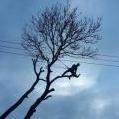Somewhere between £40 and £80 per day
There's 10s of thousands of small arb companies all over the UK, a few thousand medium/big companies and 100s of companies who do utility/line clearance work/large contracts. As in the US, the general quality and levels of professionalism with companies varies hugely. As a starting point someone coming from abroad may want to consider working for an Arboricultural Assocation Approved Contractor or an employer holding the ISA Certified Arborist qualification or similar.
Yes, some employers pay for their workers to gain NPTCs certs mainly because they have to, not necessarily because they want to, there are a few generous folk out there who will put their staff through expensive courses only for the employees to switch to another company or start their own company soon after, but then...thats life. There are many treeworkers in the UK who have paid for all their own training.
Professional employers will provide basic PPE for treework, but they'd probably be happy for you to bring your own if it met all the relevant safety standards.
Most employers in the UK will ask for the basic NPTCs at the very least before they employ you as a groundie, mainly for insurance reasons. There are a few decent folk who will take you on without the NPTCs but pay you less and give you some onsite training.
Apprenticeship schemes are basically on the job training over a period of a few years, there will be some companies/organisations in the UK running arb apprenticeships, someone else may know of them. Most decent employers will give you time to train you as you work.
good choice, very expensive place to live though
.


.jpg.e78d23f57b029caf0a7282c8ab545f75.jpg)






